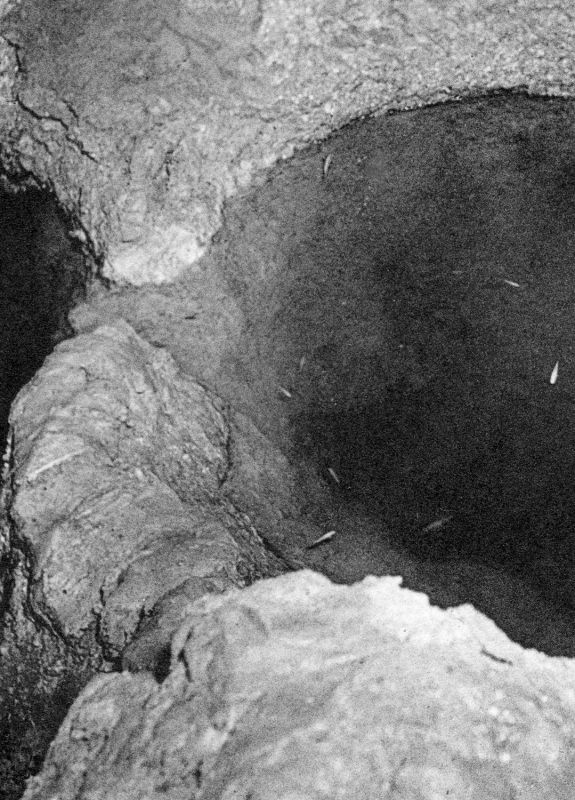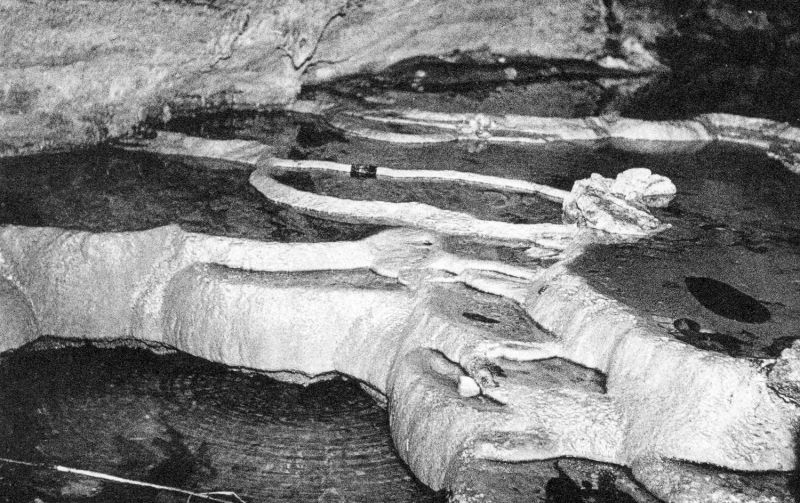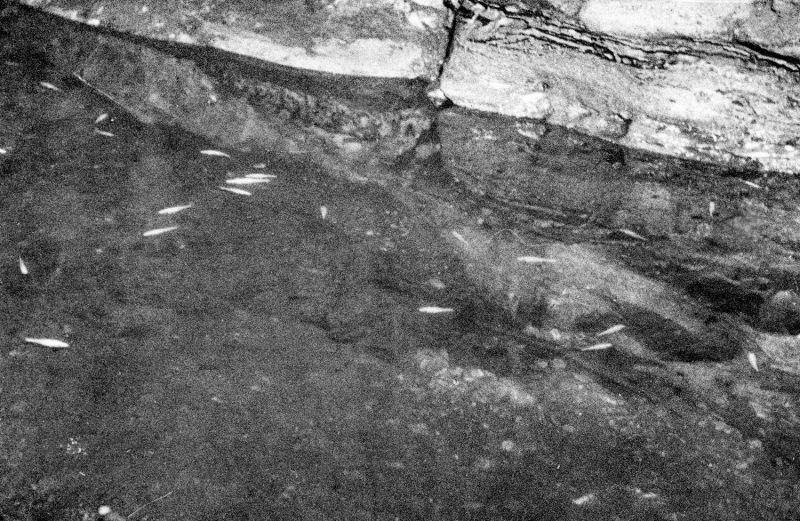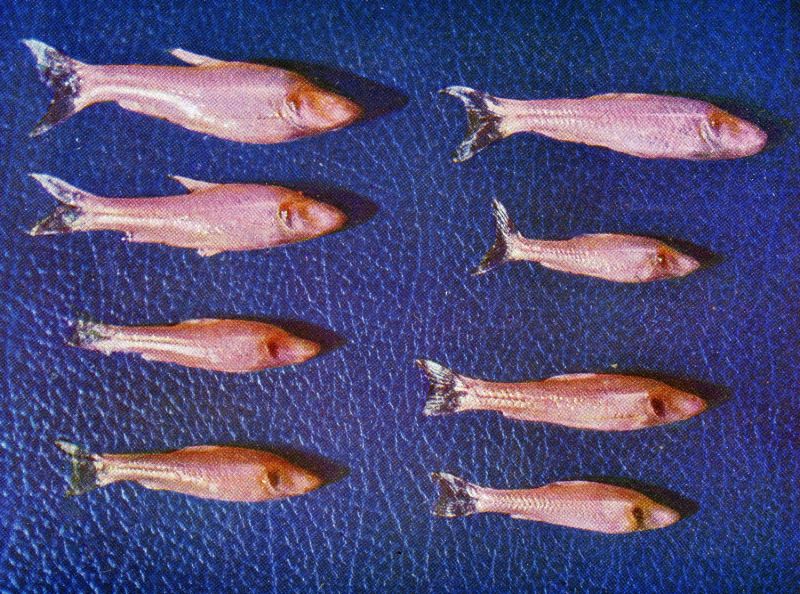Caecobarbus geertsii
Boulenger 1921
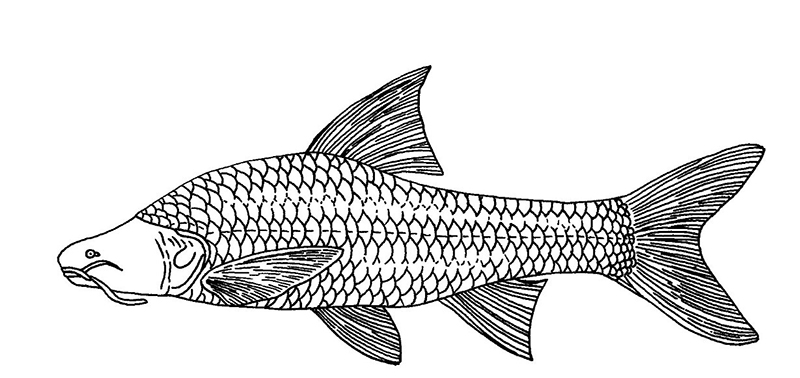
| ORDER | SUB-ORDER | FAMILY |
|---|---|---|
| Cypriniformes | Cyprinoidei | Cyprinidae |
Note
Although not formally described until 1921 (Boulenger 1921) the fishes were first observed in 1913, or earlier, (Mathieu 1913:151, Mathieu 1913, Shaw 2013:78):
"In this second part of the cave the flow of is significantly increased and basins are formed where many small white fish live."
"Animal life is poorly developed in this cave; besides the bats and white fish…"
Various other dates for its discovery are in the literature:
1914 Boulenger 1921:252,253, Wanson and Lebied 1945/46:128
1914-1915 Heuts and Leleup 1954:39, Randour 1938:36,41
1915 Office du Tourisme du Congo Belge et du Ruanda-Urundi 1949:380, Office du Tourisme du Congo Belge et du Ruanda-Urundi 1958:302, Romero and Benz 2000:126
1917 Guldentope 1969:1, Basilewsky 1957:46, Basilewsky 1971:20, Heuts 1951:155
The critical personality in the eventual description of the fish by Boulenger was Dr Henri Schouteden of the Musee Royal du Congo Belge, Tervuren (Belgium) (now the Musee Royal de l’Afrique Centrale) (Thys van den Audenaerde 1999). He cooperated with G. A. Boulenger of the British Museum (Natural History) for the description of new fish species that he and his associates collected in, what then was, the Bas Congo. Shouteden was in the Bas Congo between 1920 and 1922 and got to know G. Geerts who was managing director of the railway company that used the Matadi to Leopoldville railway. When Schouteden was in Thysville (now called Mbanza Ngungu) he met Geerts who mentioned that some of the local caves had blind fishes in them. So, some were collected and sent to Mrs Geerts in Belgium who gave them to Boulenger who had, by 1920, returned to his native Belgium. Although by this time he had ceased to work on fishes he did one final favour for Schouteden, and also for Geerts, in describing and naming this subterranean fish. So, in all probability, the fish was known about to some people as early as 1913 but it was the influence of the Museum collector Schouteden that finally it became formally described (Boulenger 1921).
Synonyms
None.
None. Boulenger (1921) spelt the specific name geertsii but it has often been spelt without the final i (geertsi) as a result of a recommendation (International Commission on Zoological Nomenclature 1961:107) made by the second edition of the International Code of Zoological Nomenclature. However, under the rules of the third and fourth editions (International Commission on Zoological Nomenclature 1985: Article 33c,d; International Commission on Zoological Nomenclature 1999: Article 33.4) this is an incorrect subsequent spelling and should not be used.
The local name for this species is Nzonzi a mpofo.
Country
Democratic Republic of the CongoTypes
The description was based on a syntype series: MRAC 14.610 - 14.612 (3 specimens), BMNH no number (1 specimen). This species is the type species by monotypy of the cave restricted genus Caecobarbus.
Distribution
Type locality: Grande Grotte de Thysville, a tributary of the Kwilu River, itself a tributary of the lower Zaire River, Democratic Republic of Congo, western Africa (05o15’S, 14o52’E). This cave is now called Lukatu Cave (UNEP WCMC 2019).
Recorded also from a further six sites in the same area: Grotte de Gaz (which has been quarried out of existence), Grotte de Nenga, Grotte de Kiasi, and three unnamed sites, B6c, B15, B20 (Heuts 1951; Heuts and Leleup 1954). Banister and Bailey (1979:210) recorded the species from "caves at Kanka near Mbanza-Ngungu (formerly Thysville), 05o18'S 14o50'E". Details of geology and other caves in the area are given by Quinif (1985).
The above described distribution is the historical known distribution known about since the fish was first discovered. Recent explorations in the Nkyende Area, 50km south of the historical range, has found several new populations of fishes which are similar to C. geertsii. However they differ in various morphological features and have a genetic distance of 1.4%-2.1% (COI, mtDNA) from the other populations. It is likely that these new popualations with be described as one ot more new species within the genus Caecobarbus, or possible in the genus Enteromius (see below) (information from Decru et al. 2018).
In the framework of the Geo-Resources for Development (GeoRes4Dev) project of the Musee Royal de l’Afrique Centrale a small team of speleologists from France and Germany started with the mapping of caves south of Mbanza Ngungu (the former Thysville) in July 2023. Twelve caves, partially not described by previous explorers were fully or partially surveyed. This included the longest cave known in the area (Grotte de Ngovo 05.31176S 14.91426E), where several specimens of Caecobarbus were catched for DNA analysis by the Museum. Six individuals were also observed in the Resurgence de Nkieza (05.31312S 181525E), a merely 81 m long and very narrow spring cave.
Grotte de Lukatu (formerly called Grande Grotte de Thysville), said to be between 1.8-2.1 km long, was also targeted by the 2023 team but was found entirely blocked by sediment about 400 m from the cave entrance. The influx origins from large deforestation-caused landslides close to the cave entrance, which acts as a sinkhole. Consequently, it is assumed that most of the cave, with a population of 4,000 individuals of Caecobarbus (as estimeted by Heuts and Leleup 1954: 43), is lost as a suitable habitat.
[Thanks to Michael Laumanns for the last two paragraphs about new exploration in the area in 2023 and the finding of new caves with this species. As their publications on this explorations are published more details will follow]
Habitat
The area of distribution is a continuous karst area but there do not appear to be connections between the seven known sites. All are vadose stream caves which carry small streams in summer but flood in winter.
Systematics
Vervoort (1980) found a chromosome complement of 2n=50 with more than 80 chromosome arms. This arrangement is common among cyprinid fishes. This, together with the absence of karyotypes for other African cyprinid species, does not allow any conclusions about relationships to be made with this method. Howes (1991) placed this species (together with Barbopsis devecchii and Garra andruzzii) in the barbin lineage of the subfamily Cyprininae. Hayes and Armbruster (2017) studied the taxonomy and relationships of the Africa small barbs, a group to which C. geertsii belongs (with Barbopsis devecchii) but a complete absence of tissue samples for these two subterranean species meant that they were excluded from the analysis. Heuts and Leleup (1954:52-54) note that the fishes in one cave, Grotte B16, have a small pigment patch on the operculum which is absent in all other populations. This may indicate that the B16 population is diverging, or divergent, from other populations (see photograph below). In a thorough phylogenetic classification of the Cypriniformes Tan and Armbruster (2018) placed Caecobarbus as incertae sedis within Cyprinidae as they were unable to determine the subfamily into which to place it.
Mullens et al. (2020) (and see also Decru et al. 2018) determined the mitochondrial genome of this species. This made it possible to determine that it is probably sister species to a species in the genus Enteromius. Nine species of Enteromius cluster in the same clade and it is therefore possible that the genus name Caecobarbus Boulenger 1921 will need to become a junior synonym of Enteromius Cope 1867. Mullens et al. (2020) refrain from making this decision in their paper, commenting that a fuller study might show that subclades of the current Enteromius may exist and that as Caecobarbus is the next oldest generic name it may be required for one of the subclades. The same study showed conclusively that Caecobarbus is a member of the subfamily Smiliogastrinae.
Biological Notes
The most important publications on the distribution and biology of Caecobarbus geertsii are Heuts (1951), Heuts and Leleup (1954), Kimbembi (2018) (in French) and Kimbembi (2023) (in English). When reading Heuts (1951) it is also important to read Breder (1953) for an alternative explanation of aspects of the biology of the fish.
Conservation Status
MG [VU B1ab(i,ii,iii,iv)+2ab(i,ii,iii,iv):3.1:2010]
R (IUCN 1990), E (IUCN 1993), VU A1e, B1+2e, D2 (IUCN 1996, 2000).
Sedimentation flowing into the caves poses the main threat to Caecobarbus geertsii. At least one cave is known to be used as a quarry. The species is known from more than five but fewer than 10 locations. The EOO and AOO are estimated to be far less than the criteria for the Vulnerable status, but the estimated number of locations restrict the assessment possibilities for this species to the Vulnerable status (Moelants 2010. Caecobarbus geertsii. The IUCN Red List of Threatened Species 2010: http://dx.doi.org/10.2305/IUCN.UK.2010-3.RLTS.T3449A9866689.en. Downloaded on 03 July 2017).
This was the first African fish to receive some statutory protection when it was placed on a list of protected animals of the (then) Belgian Congo (together with the more prominent Gorilla and Chimpanzee) (Frechkop 1941). Skelton, Tweddle and Jackson (1991:230) report that this species is collected for the aquarium trade because of its novelty. This species was listed in CITES Appendix II in 1981 (CITES 1981) to protect it from this trade. This means that an export permit is required before animals can be removed from Democratic Republic of Congo. In 1993 1500 wild caught individuals were imported into the USA, 30, source unknown, to Japan in 1994 and 6, captive-bred, to Italy in 1996 (John Caldwell, WCMC, pers. comm.). See also Proudlove and Romero (2001).
This species is found in Ecoregion 80 (Thysville Caves) of Thieme et al. (2005). This is an area of subterranean and spring systems which is globally outstanding faunistically, with a conservation status of endangered and a priority class of 1 (Reid 2005). Brooks et al. (2011) place this species in Ecoregion Lower Congo who say of it: "The Mbanzagungu (Thysville) caves which were originally classified as their own ecoregion by Thieme et al. (2005) are considered here within the Lower Congo region. These numerous limetsone caves and subterranean conduits are home to an endemic hypogean species, Caecobarbus geertsii, classified as Vulnerable. A significant threat is from sedimentation of waters in the caves, caused by surrounding agricultural development (Thieme et al. 2008). Other threats include domestic and agricultural pollution, changes in hydrology, and habitat destruction. There is increasing human population in the region and accompanying agricultural development, and the caves are also a growing tourist destination."
Decru et al. (2018) document that the total population of Caecobarbus in the original, northern, area was of the order of 8000 but that as of 2018 65-75% of them had been lost to various external issues such as mining, quarrying etc.
Museum Holdings
As above plus: MRAC 15.336 - 15.351 (Leveque and Daget 1984), BMNH 1975.6.20:492-495, 1976.10.12:304 (Banister and Bailey 1979:225).
Internet Resources
Mitochondrial genome 1 (Mullens et al. 2020, see also Decru et al. 2018)
Mitochondrial genome 2 (Mullens et al. 2020, see also Decru et al. 2018)
Genbank also contains 46 sequences of mitochondrial COI
Geo-Resources for Development (GeoRes4Dev) project of the Musee Royal de l’Afrique Centrale
Key References
- Mathieu, F.F. (1913)
- Mathieu, F.F. (1913)
- Pellegrin, J. (1921)
- Boulenger, G. A. (1921)
- Schouteden, H. (1924)
- Pellegrin, J. (1931)
- Poll, M. (1932)
- Gerard, P. (1936)
- David, L. and Poll, M. (1937)
- Petit, G. and Besnard, W. (1937)
- Randour, F. (1938)
- Petit, G. (1938)
- Frechkop, S. (1941)
- Duren, A. (1943)
- Wanson, M and Lebied, B. (1945-1946)
- Frechkop, S. (1947)
- Atz, J.W. (1949)
- Office du Tourisme du Congo Belge et du Ruanda-Urundi (1949)
- Heuts, M.J. (1950)
- Atz, J.W. (1951)
- Heuts, M. J. (1951)
- Frechkop, S. (1953)
- Heuts, M. J. (1953)
- Thines, G. (1953)
- Poll, M. (1953)
- Breder, C.M. (1953)
- Thines, G. (1954)
- Heuts, M.J. and Leleup, N. (1954)
- Olivereau, M. and Herlant, M. (1954)
- Quaghebeur, M. (1955)
- Thines, G. (1955)
- Olivereau, M. and Francotte-Henry, M. (1956)
- Leleup, N. (1956)
- Leleup, N. (1956)
- Poll, M. (1956)
- Quaghebeur, M. (1957)
- Basilewsky, P. (1957)
- Quaghebeur, M. (1957)
- Leleup, N. (1957)
- Luling, K.H. (1957)
- Office du Tourisme du Congo Belge et du Ruanda-Urundi (1958)
- Thines, G. (1958)
- Stolk, A. (1959)
- Nieuwenhuizen, A. van den (1961)
- Nieuwenhuizen, A. van den (1961)
- Guldentope, R.E. (1969)
- Thines, G. (1969)
- Basilewsky, P. (1971)
- Thines, G. and Wissocq, N. (1972)
- Thines, G. and LeGrain, J. M. (1973)
- Roberts, T.R. and Stewart, D.J. (1976)
- Vervoort, A. (1980)
- Berti, R. and Thines, G. (1980)
- CITES (1981)
- Jankowska, M. and Thines, G. (1982)
- Leveque, C. and Daget, J. (1984)
- Quinif, Y. (1985)
- Quinif, Y. (1985)
- Banister, K.E. (1986)
- Quinif, Y. (1986)
- Quinif, Y. and Dupuis, C. (1989)
- Thys van den Audenaerde, D. F. E. (1999)
- Romero, A. and Benz, K. (2000)
- Proudlove, G.S. and Romero, A. (2001)
- Decu, V., Juberthie, C. and Tercafs, R. (2001)
- Thieme, M.L., Abell, R., Stiassny, M.L.J.,Skelton, P., Lehner, B., Teugels, G., Dinerstein, E., Kamdem-Toham, A., Burgess, B., and Olson, D. (2005)
- Brown, A. and Abell, R. (2005)
- Kimbembi ma Ibaka A. and Boki F. (2006)
- Kimbembi ma Ibaka, A. (2007)
- Thieme, M., Shapiro, A., Colom, A., Schliewen, U., Sindorf, N. and Kamdem Toham, A. (2008)
- Hanssens, M., Vreven, J., E. and Snoeks, J. (2008)
- Kimbembi, ma Ibaka, A. (2009)
- Moelants, T. (2009)
- Darwall, W.R.T., Smith, K.G., Allen, D.J., Holland, R.A, Harrison, I.J., and Brooks, E.G.E. (2011)
- Brooks, E.G.E., Allen, D.J. and Darwall, W.R.T. (2011)
- Vreven, E., Kimbembi ma Ibaka, A. and Wamuini, S. (2011)
- Kimbembi, ma Ibaka, A. (2012)
- Shaw, J.G. (2013)
- Kimbembi, A., Wamuini Lunkayilakio, S., Bansimba Mukiese, J-R., Mbungu, S.M. and Musubao Pzinza, P. (2014)
- Hayes, M.M. and Armbruster, J. (2017)
- Laumanns, M. (2017)
- Decru, E., Van Ginneken, M., Vreven, E., Kimbembi, A., Verheyen, E. and Snoeks, J. (2018)
- Decru, E., Kimbembi, A., Wamuini, S.L., Kosi, D, Snoeks, J. and Vreven, E. (2018)
- Kimbembi ma Ibaka, A. (2018)
- UNEP-WCMC (2019)
- Mullens, N., Sonet, G., Decru, E., Virgilio, M., Snoeks, J. Vreven, E. (2020)
- Kimbembi ma Ibaka, A. (2023)
| Mathieu, F.F. | Journal Article | 1913 | Note sur la geologie des environs de Thysville |
| Mathieu, F.F. | Journal Article | 1913 | Note sur la geologie des environs de Thysville |
| Pellegrin, J. | Journal Article | 1921 | Les poissons des eaux douces de l'Afrique de nord francaise (Maroc, Algerie, Tunisie, Sahara) |
| Boulenger, G. A. | Journal Article | 1921 | Description d'un poisson aveugle decouvert par M. G. Geerts dans la grotte de Thysville (Bas-Congo) |
| Schouteden, H. | Journal Article | 1924 | Un poisson congolais aveugle |
| Pellegrin, J. | Journal Article | 1931 | Les Cyprinides cavernicoles d'Afrique |
| Poll, M. | Journal Article | 1932 | Les poissons cavernicoles aveugles africains |
| Gerard, P. | Journal Article | 1936 | Sur l'existence de vestiges oculaires chez Caecobarbus geertsii |
| David, L. and Poll, M. | Journal Article | 1937 | Contribution a la faune ichthyologique de Congo Belge. Collections du Dr H. Schouteden (1924-1926) et d'autres recolteurs |
| Petit, G. and Besnard, W. | Journal Article | 1937 | Sur le comportement en aquarium du Caecobarbus geertsii Blgr |
| Randour, F. | Book Section | 1938 | Excursions au depart de Matadi. le tourisme a Thysville |
| Petit, G. | Journal Article | 1938 | Au sujet de Caecobarbus geertsii Boulenger |
| Frechkop, S. | Book | 1941 | Animaux proteges au Congo Belge |
| Duren, A. | Journal Article | 1943 | La pêche en eau douce au Congo belge. 3. Les poissons d’eau douce les plus connus du Congo belge. |
| Wanson, M and Lebied, B. | Journal Article | 1945-1946 | Un nouvel Anophele cavernicole de Congo belge: Anopheles (Myzomyia) vanhoofi spec. nov. |
| Frechkop, S. | Book | 1947 | Animaux proteges au Congo Belge |
| Atz, J.W. | Journal Article | 1949 | Sightless cave fishes from the Bas Congo |
| Office du Tourisme du Congo Belge et du Ruanda-Urundi | Book | 1949 | Guide du voyageur au Congo Belge et au Ruanda-Urundi |
| Heuts, M.J. | Conference Paper | 1950 | Geographical distribution, ecology and variability of the African blind cave fish, Caecobarbus geertsi |
| Atz, J.W. | Journal Article | 1951 | Sightless cave fishes rom the Bas Congo |
| Heuts, M. J. | Journal Article | 1951 | Ecology, variation and adaptation of the blind African cave fish Caecobarbus geertsii Blgr |
| Frechkop, S. | Book | 1953 | Animaux proteges au Congo Belge |
| Heuts, M. J. | Journal Article | 1953 | Regressive evolution in cave animals |
| Thines, G. | Journal Article | 1953 | Recherches experimentales sur la photosensibilite du poisson aveugle Caecobarbus geertsi Boulenger |
| Poll, M. | Journal Article | 1953 | Les poissons d’aquarium du Congo belge. |
| Breder, C.M. | Journal Article | 1953 | Cave fish evolution |
| Thines, G. | Journal Article | 1954 | Etude comparative de la photosensibilite des poissons aveugles Caecobarbus geertsii Blgr et Anoptichthys jordani Hubbs et Innes |
| Heuts, M.J. and Leleup, N. | Journal Article | 1954 | La geographie et l'ecologie des grottes du Bas-Congo: les habitats de Caecobarbus geertsii Blgr |
| Olivereau, M. and Herlant, M. | Journal Article | 1954 | Etude histologique de l'hypophyse de Caecobarbus geertsi |
| Quaghebeur, M. | Thesis | 1955 | Onderzoekingen over blinde grotvissen in Verband Met de reductie in de ontwikkeling van hun ogen |
| Thines, G. | Journal Article | 1955 | Les poissons aveugle. I Origine, taxonomie, reparition geographique, comportement |
| Olivereau, M. and Francotte-Henry, M. | Journal Article | 1956 | Etude histologique et biometrique de la glande thyroide de Caecobarbus geertsi |
| Leleup, N. | Journal Article | 1956 | La faune cavernicole du Congo Belge et considerations sur les coleopteres reliques d'Afrique intertropicale |
| Leleup, N. | Journal Article | 1956 | Description de deux grottes du Bas-Congo |
| Poll, M. | Journal Article | 1956 | Les poissons du Congo Belge et l’aquariophilie |
| Quaghebeur, M. | Thesis | 1957 | Onderzoek over de reductie van de ogen, van de oogkas en van het tectum opticum bij blinde grotvissen |
| Basilewsky, P. | Journal Article | 1957 | Les grottes de Thysville |
| Quaghebeur, M. | Thesis | 1957 | Etude histologique et biometrique de l'oeil de Caecobarbus |
| Leleup, N. | Journal Article | 1957 | La faune cavernicole du Congo Belge |
| Luling, K.H. | Journal Article | 1957 | Caecobarbus geertsi Boulenger - seine Entdeckung, verbreitung und Lebensweise - und nochmals Anoptichthys jordani Hubbs und Innes |
| Office du Tourisme du Congo Belge et du Ruanda-Urundi | Journal Article | 1958 | Office du Tourisme du Congo Belge et du Ruanda-Urundi |
| Thines, G. | Journal Article | 1958 | Beobachtungen uber die Phototaxis und die Thermotaxis des blinden Hohlenfisches, Caecobarbus geertsi (Cyprinidae) |
| Stolk, A. | Journal Article | 1959 | Experimenten met grotbewonende vissen |
| Nieuwenhuizen, A. van den | Journal Article | 1961 | Caecobarbus geertsi. Bericht uit Thysstad |
| Nieuwenhuizen, A. van den | Journal Article | 1961 | Caecobarbus geertsi, bericht uit Thysstad (naar gegevens van Julien de Beer) |
| Guldentope, R.E. | Journal Article | 1969 | Cinquante cinq annees d'activites des speleologues belges dans le Bas-Congo 1915-1970 |
| Thines, G. | Book | 1969 | L'Evolution regressive des poissons cavernicoles et abyssaux |
| Basilewsky, P. | Journal Article | 1971 | Les grottes de Thysville |
| Thines, G. and Wissocq, N. | Journal Article | 1972 | Etude comparee du comportement alimentaire de deux poissons cavenicoles (Anoptichthys jordani Hubbs et Innes et Ceacobarbus geertsii Blgr) |
| Thines, G. and LeGrain, J. M. | Journal Article | 1973 | Effets de la substance d'alarme sur le comportement des poissons cavernicoles Anoptichthys jordani (Characidae) et Caecobarbus geertsii (Cyprinidae) |
| Roberts, T.R. and Stewart, D.J. | Journal Article | 1976 | An ecological and systematic survey of fishes in the rapids of the lower Zaire or Congo river |
| Vervoort, A. | Journal Article | 1980 | Karyotype of Caecobarbus geertsii (Teleostei, Cyprinidae) |
| Berti, R. and Thines, G. | Journal Article | 1980 | Influence of chemical signals on the topographic orientation of the cave fish Caecobarbus geertsi Boulenger (Pisces, Cyprinidae) |
| CITES | Journal Article | 1981 | Proposal to include Caecobarbus geertsi and Appendix I and all other species of blind cave fishes (except the species commercially known as Anoptichthys jordani) in Appendix II |
| Jankowska, M. and Thines, G. | Journal Article | 1982 | Etude comparative de la densite de groupes de poissons cavernicoles et epigee (Characidae, Cyprinidae, Clariidae) |
| Leveque, C. and Daget, J. | Book Section | 1984 | Caecobarbus geertsii Boulenger, 1921 |
| Quinif, Y. | Journal Article | 1985 | Kwilu 84 - Expedition speleologique dans la bas-Congo |
| Quinif, Y. | Journal Article | 1985 | Une morphologie karstique typique en zone intertropicale: les karsts de Bas-Congo |
| Banister, K.E. | Book Section | 1986 | Fish of the Zaire System |
| Quinif, Y. | Journal Article | 1986 | Genese des karsts a tours en pays intertropicale: l'example du Bas-Congo |
| Quinif, Y. and Dupuis, C. | Journal Article | 1989 | Morphologie et hydrologie d'um karst couvert: le reseau de Ziaka (Bas-Congo) |
| Thys van den Audenaerde, D. F. E. | Journal Article | 1999 | A peacock, a blind barbel, a railway wagon and a disappointed ichthyologist |
| Romero, A. and Benz, K. | Journal Article | 2000 | The unsung heroes of speleology |
| Proudlove, G.S. and Romero, A. | Journal Article | 2001 | Threatened fishes of the world: Caecobarus geertsii Boulenger, 1921 (Cyprinidae) |
| Decu, V., Juberthie, C. and Tercafs, R. | Book Section | 2001 | Republique Democratique Du Congo (ex-Zaire) |
| Thieme, M.L., Abell, R., Stiassny, M.L.J.,Skelton, P., Lehner, B., Teugels, G., Dinerstein, E., Kamdem-Toham, A., Burgess, B., and Olson, D. | Book | 2005 | Freshwater ecoregions of Africa and Madagascar. A conservation assessment |
| Brown, A. and Abell, R. | Book Section | 2005 | Ecoregion 80. Thysville Caves |
| Kimbembi ma Ibaka A. and Boki F. | Journal Article | 2006 | Données préliminaires sur le coefficient de condition du Caecobarbus geertsii des grottes de la contrée de Mbanza-Ngungu, cas de la grotte de Nzonzi |
| Kimbembi ma Ibaka, A. | Thesis | 2007 | Approche systémique de la conservation des grottes de Mbanza-Ngungu, contribution a l’étude de la biodiversité cavernicole et proposition de création d’une aire protégée. |
| Thieme, M., Shapiro, A., Colom, A., Schliewen, U., Sindorf, N. and Kamdem Toham, A. | Report | 2008 | Inventaire rapide des zones humides représentatives en République Démocratique du Congo |
| Hanssens, M., Vreven, J., E. and Snoeks, J. | Conference Paper | 2008 | The ichthyofauna of Lower Congo and Pool Malebo |
| Kimbembi, ma Ibaka, A. | Journal Article | 2009 | Decouvert de nouveaux sites a Caecobarbus geertsii Blgr. 1921 a Mbanza-Ngungu |
| Moelants, T. | Journal Article | 2009 | Caecobarbus geertsii |
| Darwall, W.R.T., Smith, K.G., Allen, D.J., Holland, R.A, Harrison, I.J., and Brooks, E.G.E. | Book | 2011 | The diversity of life in African freshwaters: Under water, under threat. An analysis of the status and distribution of freshwater species throughout mainland Africa |
| Brooks, E.G.E., Allen, D.J. and Darwall, W.R.T. | Book | 2011 | The status and distribution of freshwater diversity in central Africa |
| Vreven, E., Kimbembi ma Ibaka, A. and Wamuini, S. | Book Section | 2011 | The Congo blind barb: Mbanza-Ngungu's albino cave fish |
| Kimbembi, ma Ibaka, A. | Journal Article | 2012 | Degradation des grottes aux poissons aveugles (Caecobarbus geertsii Boulenger 1921, Teleostei Cyprinidae) dans la region de Mbanza Ngungu en R.D. Congo et proposition d'une aire protegee |
| Shaw, J.G. | Book | 2013 | Caves of the Democratic Republic of Congo Exploration, Science and History |
| Kimbembi, A., Wamuini Lunkayilakio, S., Bansimba Mukiese, J-R., Mbungu, S.M. and Musubao Pzinza, P. | Book Section | 2014 | Etat des lieux de la biodiversite – 2014 Province de Bas-Congo |
| Hayes, M.M. and Armbruster, J. | Journal Article | 2017 | The taxonomy and relationships of the African small barbs (Cypriniformes: Cyprinidae) |
| Laumanns, M. | Journal Article | 2017 | Atlas of the great caves and the karst of Africa. Part 1. Introduction and Algeria to Madagascar |
| Decru, E., Van Ginneken, M., Vreven, E., Kimbembi, A., Verheyen, E. and Snoeks, J. | Conference Paper | 2018 | Hidden diversity in the small African barbs |
| Decru, E., Kimbembi, A., Wamuini, S.L., Kosi, D, Snoeks, J. and Vreven, E. | Conference Paper | 2018 | Eye-opening discoveries on the threatened blind Congo minnow Caecobarbus geertsii |
| Kimbembi ma Ibaka, A. | Book | 2018 | Grottes aux poissons aveugles: Caecobarbus geertsii de Mbanza-Ngungu en R.D.Congo |
| UNEP-WCMC | Report | 2019 | Review of species selected on the basis of the analysis of 2018 CITES export quotas. Part II. |
| Mullens, N., Sonet, G., Decru, E., Virgilio, M., Snoeks, J. Vreven, E. | Journal Article | 2020 | Mitogenomic characterization and systematic placement of the Congo blind barb Caecobarbus geertsii (Cypriniformes: Cyprinidae) |
| Kimbembi ma Ibaka, A. | Book | 2023 | Caves with blind fish:Caecobarbus geertsii de Mbanza-Ngungu en R.D.Congo |
